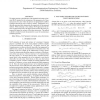Free Online Productivity Tools
i2Speak
i2Symbol
i2OCR
iTex2Img
iWeb2Print
iWeb2Shot
i2Type
iPdf2Split
iPdf2Merge
i2Bopomofo
i2Arabic
i2Style
i2Image
i2PDF
iLatex2Rtf
Sci2ools
ICASSP
2011
IEEE
2011
IEEE
MAP-based estimation of the parameters of non-stationary Gaussian processes from noisy observations
The paper proposes a modification of the standard maximum a posteriori (MAP) method for the estimation of the parameters of a Gaussian process for cases where the process is superposed by additive Gaussian observation errors of known variance. Simulations on artificially generated data demonstrate the superiority of the proposed method. While reducing to the ordinary MAP approach in the absence of observation noise, the improvement becomes the more pronounced the larger the variance of the observation noise. The method is further extended to track the parameters in case of non-stationary Gaussian processes.
Additive Gaussian Observation | ICASSP 2011 | Non-stationary Gaussian Processes | Observation Noise | Signal Processing |
| Added | 20 Aug 2011 |
| Updated | 20 Aug 2011 |
| Type | Journal |
| Year | 2011 |
| Where | ICASSP |
| Authors | Alexander Krueger, Reinhold Haeb-Umbach |
Comments (0)

